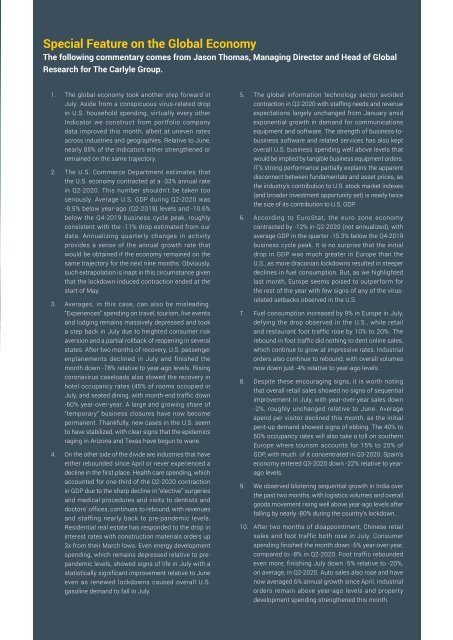Create successful ePaper yourself
Turn your PDF publications into a flip-book with our unique Google optimized e-Paper software.
Special Feature on the Global Economy<br />
The following commentary comes from Jason Thomas, Managing Director and Head of Global<br />
Research for The Carlyle Group.<br />
1. The global economy took another step forward in<br />
July. Aside from a conspicuous virus-related drop<br />
in U.S. household spending, virtually every other<br />
Indicator we construct from portfolio company<br />
data improved this month, albeit at uneven rates<br />
across industries and geographies. Relative to June,<br />
nearly 85% of the Indicators either strengthened or<br />
remained on the same trajectory.<br />
2. The U.S. Commerce Department estimates that<br />
the U.S. economy contracted at a -33% annual rate<br />
in Q2-<strong>2020</strong>. This number shouldn’t be taken too<br />
seriously. Average U.S. GDP during Q2-<strong>2020</strong> was<br />
-9.5% below year-ago (Q2-2019) levels and -10.6%<br />
below the Q4-2019 business cycle peak, roughly<br />
consistent with the -11% drop estimated from our<br />
data. Annualizing quarterly changes in activity<br />
provides a sense of the annual growth rate that<br />
would be obtained if the economy remained on the<br />
same trajectory for the next nine months. Obviously,<br />
such extrapolation is inapt in this circumstance given<br />
that the lockdown-induced contraction ended at the<br />
start of May.<br />
3. Averages, in this case, can also be misleading.<br />
“Experiences” spending on travel, tourism, live events<br />
and lodging remains massively depressed and took<br />
a step back in July due to heighted consumer risk<br />
aversion and a partial rollback of reopening in several<br />
states. After two months of recovery, U.S. passenger<br />
enplanements declined in July and finished the<br />
month down -78% relative to year-ago levels. Rising<br />
coronavirus caseloads also slowed the recovery in<br />
hotel occupancy rates (45% of rooms occupied in<br />
July; and seated dining, with month-end traffic down<br />
-60% year-over-year. A large and growing share of<br />
“temporary” business closures have now become<br />
permanent. Thankfully, new cases in the U.S. seem<br />
to have stabilized, with clear signs that the epidemics<br />
raging in Arizona and Texas have begun to wane.<br />
4. On the other side of the divide are industries that have<br />
either rebounded since April or never experienced a<br />
decline in the first place. Health care spending, which<br />
accounted for one-third of the Q2-<strong>2020</strong> contraction<br />
in GDP due to the sharp decline in “elective” surgeries<br />
and medical procedures and visits to dentists and<br />
doctors’ offices, continues to rebound, with revenues<br />
and staffing nearly back to pre-pandemic levels.<br />
Residential real estate has responded to the drop in<br />
interest rates with construction materials orders up<br />
3x from their March lows. Even energy development<br />
spending, which remains depressed relative to prepandemic<br />
levels, showed signs of life in July with a<br />
statistically significant improvement relative to June<br />
even as renewed lockdowns caused overall U.S.<br />
gasoline demand to fall in July.<br />
5. The global information technology sector avoided<br />
contraction in Q2-<strong>2020</strong> with staffing needs and revenue<br />
expectations largely unchanged from January amid<br />
exponential growth in demand for communications<br />
equipment and software. The strength of business-tobusiness<br />
software and related services has also kept<br />
overall U.S. business spending well above levels that<br />
would be implied by tangible business equipment orders.<br />
IT’s strong performance partially explains the apparent<br />
disconnect between fundamentals and asset prices, as<br />
the industry’s contribution to U.S. stock market indexes<br />
(and broader investment opportunity set) is nearly twice<br />
the size of its contribution to U.S. GDP.<br />
6. According to EuroStat, the euro zone economy<br />
contracted by -12% in Q2-<strong>2020</strong> (not annualized), with<br />
average GDP in the quarter -15.3% below the Q4-2019<br />
business cycle peak. It is no surprise that the initial<br />
drop in GDP was much greater in Europe than the<br />
U.S., as more draconian lockdowns resulted in steeper<br />
declines in fuel consumption. But, as we highlighted<br />
last month, Europe seems poised to outperform for<br />
the rest of the year with few signs of any of the virusrelated<br />
setbacks observed in the U.S.<br />
7. Fuel consumption increased by 9% in Europe in July,<br />
defying the drop observed in the U.S., while retail<br />
and restaurant foot traffic rose by 10% to 20%. The<br />
rebound in foot traffic did nothing to dent online sales,<br />
which continue to grow at impressive rates. Industrial<br />
orders also continue to rebound, with overall volumes<br />
now down just -4% relative to year-ago levels.<br />
8. Despite these encouraging signs, it is worth noting<br />
that overall retail sales showed no signs of sequential<br />
improvement in July, with year-over-year sales down<br />
-2%, roughly unchanged relative to June. Average<br />
spend per visitor declined this month, as the initial<br />
pent-up demand showed signs of ebbing. The 40% to<br />
50% occupancy rates will also take a toll on southern<br />
Europe where tourism accounts for 15% to 25% of<br />
GDP, with much of it concentrated in <strong>Q3</strong>-<strong>2020</strong>. Spain’s<br />
economy entered <strong>Q3</strong>-<strong>2020</strong> down -22% relative to yearago<br />
levels.<br />
9. We observed blistering sequential growth in India over<br />
the past two months, with logistics volumes and overall<br />
goods movement rising well above year-ago levels after<br />
falling by nearly -80% during the country’s lockdown.<br />
10. After two months of disappointment, Chinese retail<br />
sales and foot traffic both rose in July. Consumer<br />
spending finished the month down -5% year-over-year,<br />
compared to -8% in Q2-<strong>2020</strong>. Foot traffic rebounded<br />
even more, finishing July down -5% relative to -20%,<br />
on average, in Q2-<strong>2020</strong>. Auto sales also rose and have<br />
now averaged 6% annual growth since April. Industrial<br />
orders remain above year-ago levels and property<br />
development spending strengthened this month.<br />
THIRD QUARTER <strong>2020</strong> — ASIAN SKY QUARTERLY | 35

















